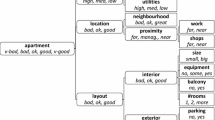Abstract
Decision analysis is aimed at supporting people who make decisions in order to satisfy their needs and objectives. The method called DEX is a qualitative multi-criteria decision analysis approach that provides support to decision makers in evaluating and choosing decision alternatives by using discrete attributes and rule-based utility functions. In this work, we extend our previous efforts of approximating complete, monotone DEX utility functions with methods Direct marginals, UTADIS and Conjoint analysis to incompletely defined utility functions. The experiments are performed both on functions obtained by solving real world decision making problems and on artificially created ones. The results show that all three methods provide accurate approximations of incompletely defined DEX utility functions, when the evaluation is done only on rules present in these incompletely defined functions. Among the three methods, the Conjoint analysis method generally has the best performance, however it is closely followed by the Direct marginals method. The Conjoint analysis method also achieves a better performance in approximating fully defined DEX utility functions by using incompletely defined instances of those functions. The UTADIS method performs comparatively well with functions having a high percentage of missing values.





Similar content being viewed by others
References
Agarwal J, DeSarbo WS, Malhotra NK, Rao VR (2015) An interdisciplinary review of research in conjoint analysis: recent developments and directions for future research. Cust Needs Solut 2(1):19–40
Bak A (2012) Conjoint analysis method and its implementation in conjoint R package. In: Pociecha J, Decker R (eds) Data analysis methods and its applications. C.H. Beck, pp 239–248
Błaszczyński J, Greco S, Słowiński R, Szeląg M (2009) Monotonic variable consistency rough set approaches. Int J Approx Reason 50(7):979–999
Bohanec M (2015) DEXi: Program for Multi-Attribute Decision Making, User’s Manual, Version 5.00. IJS Report DP-11897, Ljubljana: Jožef Stefan Institute
Bohanec M, Zupan B (2004) A function-decomposition method for development of hierarchical multi-attribute decision models. Decis Support Syst 36:215–233
Bohanec M, Urh B, Rajkovič V (1992) Evaluating options by combined qualitative and quantitative methods. Acta Psychol 80:67–89
Bohanec M, Rajkovič V, Bratko I, Zupan B, Žnidaršič M (2013) DEX methodology: three decades of qualitative multi-attribute modelling. Informatica 37:49–54
Devaud JM, Groussaud G, Jacquet-Lagreze E (1980) UTADIS: une methode de construction de fonctions d’utilite additives rendant compte de jugements globaux. European working group on MCDA, Bochum
Ehrgott M, Figueira JR, Greco S (2010) Trends in multiple criteria decision analysis. International series in operations research and management science, vol 142. Springer, New York
Fawcett T (2006) An introduction to ROC analysis. Pattern Recogn. Lett. 14:861–874
Figueira JR, Greco S, Ehrgott M (2005) Multiple criteria decision analysis: state of the art surveys. Springer, Boston
Greco S, Matarazzo B, Slowinski R (2001) Rough sets theory for multicriteria decision analysis. Eur J Oper Res 129(1):1–47
Greco S, Matarazzo B, Słowiński R (2004) Axiomatic characterization of a general utility function and its particular cases in terms of conjoint measurement and rough-set decision rules. Eur J Oper Res 158(2):271–292
Green PE, Srinivasan V (1990) Conjoint analysis in marketing: new developments with implications for research and practice. J Mark 54(4):3–19
Hyndman RJ, Koehler AB (2006) Another look at measures of forecast accuracy. Int J Forecast 22(4):679–688
Ishizaka A, Nemery P (2013) Multi-criteria decision analysis: methods and software. Wiley, Somerset
Jacquet-Lagreze E, Siskos J (1982) Assessing a set of additive utility functions for multicriteria decision-making, the UTA method. Eur J Oper Res 10(2):151–164
Kadziński M, Greco S, Słowiński R (2014) Robust ordinal regression for dominance-based rough set approach to multiple criteria sorting. Inf Sci 283:211–228
Meyer P, Bigare S (2015) Package ’MCDA’ http://cran.r-project.org/web/packages/MCDA/MCDA [13.05.2015]
Mihelčić M, Bohanec M (2014) Approximating DEX utility functions with methods UTA and ACUTA. In: Piltaver R et al (eds) Proceedings of 17th international conference information society IS 2014, vol A. Institut Jožef Stefan, Ljubljana, pp 62–65
Mihelčić M, Bohanec M (2015) Empirical comparison of three methods for approximating DEX utility functions. In: Zadnik Stirn L et al (eds) Proceedings of the 13th international symposium on operational research in Slovenia. Slovenian Society Informatika, Section for Operational Research, Ljubljana, pp 29–34
Mileva-Boshkoska B, Bohanec M (2012) A method for ranking non-linear qualitative decision preferences using copulas. Int J Decis Support Syst Technol 4(2):42–58
Ouerdane W, Maudet N, Tsoukiàs A (2010) Argumentation theory and decision aiding. In: Ehrgott M (ed) Trends in multiple criteria decision analysis. International series in operations research and management science, vol 142. Springer, New York, pp 177–208
Robin X, Turck N, Hainard A, Tiberti N, Lisacek F, Sanchez JC, Müller M (2011) pROC: an open-source package for R and S+ to analyze and compare ROC curves. BMC Bioinf 12:77
Roy B (1996) Multicriteria methodology for decision aiding. Kluwer Academic Publishers, Dordrecht
Siskos Y, Grigouridis E, Matsatsinis NF (2005) UTA methods. In: Figueira JR et al (eds) Multiple criteria decision analysis: state of the art surveys. Springer, Boston, pp 297–343
Yang J-B (2001) Rule and utility based evidential reasoning approach for multiattribute decision analysis under uncertainties. Eur J Oper Res 131(1):31–61
Author information
Authors and Affiliations
Corresponding author
Rights and permissions
About this article
Cite this article
Mihelčić, M., Bohanec, M. Approximating incompletely defined utility functions of qualitative multi-criteria modeling method DEX. Cent Eur J Oper Res 25, 627–649 (2017). https://doi.org/10.1007/s10100-016-0451-x
Published:
Issue Date:
DOI: https://doi.org/10.1007/s10100-016-0451-x




